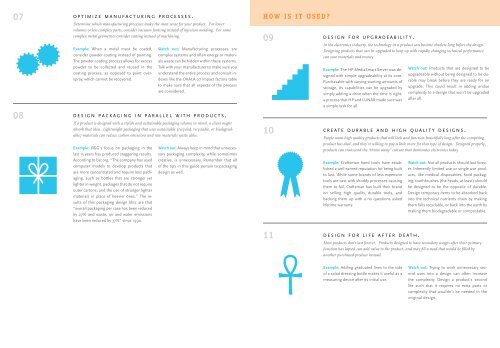THE DEsIGnER's FIELD GuIDE TO susTAInAbILITY - Lunar Design
THE DEsIGnER's FIELD GuIDE TO susTAInAbILITY - Lunar Design
THE DEsIGnER's FIELD GuIDE TO susTAInAbILITY - Lunar Design
Create successful ePaper yourself
Turn your PDF publications into a flip-book with our unique Google optimized e-Paper software.
07<br />
08<br />
o p t i m i z e m a n u f a c t u r i n g p r o c e s s e s .<br />
Determine which manufacturing processes make the most sense for your product. For lower<br />
volumes or less complex parts, consider vacuum forming instead of injection molding. For some<br />
complex metal geometries consider casting instead of machining.<br />
Example: When a metal must be coated,<br />
consider powder coating instead of painting.<br />
The powder coating process allows for excess<br />
powder to be collected and reused in the<br />
coating process, as opposed to paint overspray,<br />
which cannot be recovered.<br />
Watch out: Manufacturing processes are<br />
complex systems and often energy or materials<br />
waste can be hidden within these systems.<br />
Talk with your manufacturer to make sure you<br />
understand the entire process and consult indexes<br />
like the OKALA 07 impact factors table<br />
to make sure that all aspects of the process<br />
are considered.<br />
d e s i g n p a c k a g i n g i n p a r a l l e l w i t h p r o d u c t s .<br />
If a product is designed with a stylish and sustainable packaging scheme in mind, a client might<br />
absorb that idea. Lightweight packaging that uses sustainable (recycled, recyclable, or biodegradable)<br />
materials can reduce carbon emissions and raw materials waste alike.<br />
Example: P&G’s focus on packaging in the<br />
last 15 years has produced staggering results.<br />
According to bsr.org, “The company has used<br />
computer models to develop products that<br />
are more concentrated and require less packaging,<br />
such as bottles that are stronger yet<br />
lighter in weight, packages that do not require<br />
outer cartons, and the use of stronger lighter<br />
materials in place of heavier ones.” The results<br />
of this packaging design blitz are that<br />
“overall packaging per case has been reduced<br />
by 27% and waste, air and water emissions<br />
have been reduced by 37%” since 1990.<br />
Watch out: Always keep in mind that unnecessary<br />
packaging complexity, while sometimes<br />
creative, is unnecessary. Remember that all<br />
of the tips in this guide pertain to packaging<br />
design as well.<br />
HOW IS IT USED?<br />
09<br />
10<br />
11<br />
d e s i g n f o r u p g r a d e a b i l i t y .<br />
In the electronics industry, the technology in a product can become obsolete long before the design.<br />
<strong>Design</strong>ing products that can be upgraded to keep up with rapidly changing technical performance<br />
can save materials and money.<br />
Example: The HP MediaSmart Server was designed<br />
with simple upgradeability at its core.<br />
Purchasable with varying starting amounts of<br />
storage, its capabilities can be upgraded by<br />
simply adding a drive when the time is right:<br />
a process that HP and LUNAR made sure was<br />
a simple task for all.<br />
Watch out: Products that are designed to be<br />
upgradeable without being designed to be durable<br />
may break before they are ready for an<br />
upgrade. This could result in adding undue<br />
complexity to a design that won’t be upgraded<br />
after all.<br />
c r e a t e d u r a b l e a n d h i g h q u a l i t y d e s i g n s .<br />
People want high quality products that will look and function beautifully long after the competing<br />
product has died, and they’re willing to pay a little more for that type of design. <strong>Design</strong>ed properly,<br />
products can transcend the “throw away” culture that dominates electronics today.<br />
Example: Craftsman hand tools have established<br />
a well earned reputation for being built<br />
to last. While some brands of less expensive<br />
tools are cast with shoddy processes causing<br />
them to fail, Craftsman has built their brand<br />
on selling high quality, durable tools, and<br />
backing them up with a no questions asked<br />
lifetime warranty.<br />
d e s i g n f o r l i f e a f t e r d e a t h .<br />
Watch out: Not all products should last forever.<br />
Inherently limited use or single use products,<br />
like medical disposables, food packaging,<br />
toothbrushes (the heads, at least) should<br />
be designed to be the opposite of durable.<br />
<strong>Design</strong> temporary items to be absorbed back<br />
into the technical nutrients chain by making<br />
them fully recyclable, or back into the earth by<br />
making them biodegradable or compostable.<br />
Most products don’t last forever. Products designed to have secondary usages after their primary<br />
function has lapsed can add value to the product, and may fill a need that would be filled by<br />
another purchased product instead.<br />
Example: Adding graduated lines to the side<br />
of a salad dressing bottle makes it useful as a<br />
measuring device after its initial use.<br />
Watch out: Trying to work unnecessary second<br />
uses into a design can often increase<br />
the complexity. <strong>Design</strong> a product’s second<br />
life such that it requires no extra parts or<br />
complexity that wouldn’t be needed in the<br />
original design.


